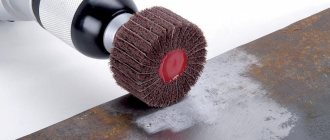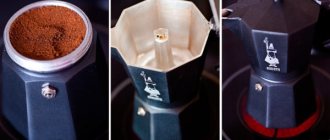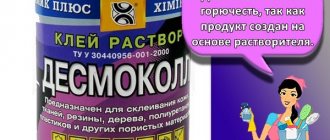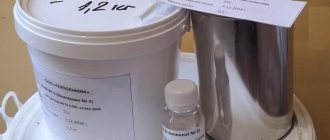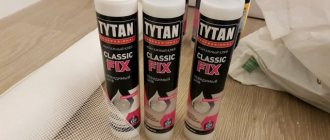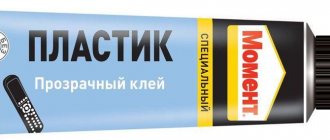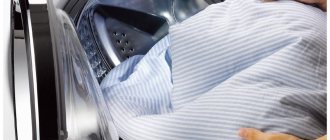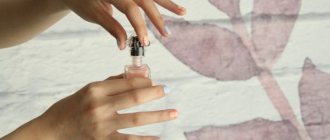Rhinestones are shiny stones that have captivated everyone, from needlewomen to designers. They decorate various accessories, clothing, and decorative interior items. A reliable connection is ensured by special glue for rhinestones. Sometimes it is already applied to the back of the bead, and sometimes you need to look for it in the store. How to choose the right glue and use it for its intended purpose?
How to choose glue
Stones can be sewn on (with holes for thread) and glued, the latter are divided into cold fastening crystals (glue must be used) and thermal rhinestones (the lower surface is covered with a dry mixture that melts at high temperatures).
Rhinestones are an imitation of precious stones that can be used to decorate clothes and other things.
Most often, to attach stones with cold fastening, they use:
- Epoxy resin: a universal product that can be used on any surface except glass. However, epoxy often leaves marks and takes several hours to dry completely;
- Special adhesive mixtures: are distinguished by convenient packaging (often with a sharp spout through which a small amount of substance is squeezed out), suitable composition that does not spoil fabric and stone, and good results.
If there is a layer of dry glue on the back side, these are hot-melt crystals.
Do not use glue for rhinestones on fabric that contains acetone or acetic acid - they will have a bad effect on the appearance of the product.
It is important to note thermal rhinestones: how to glue them to fabric is described below. To work with them you will need a heating device.
Glue "Moment-Crystal"
Transparent, easy to apply, hardens quickly, sets in a few seconds, but stretches a little, after which it will be impossible to change the position of the rhinestone or remove it without damaging the fabric. When a drop is applied, a film is formed on its surface: when installing the crystal, it may tear, and the glue will leak out and may land on a nearby surface.
The disadvantages include an unpleasant odor: if you work at home for a long time, it can cause a headache.
“Moment” is a common version of glue that can be bought in any store.
Glue for rhinestones Danscouture (USA)
It is water-based and can be used when working with any type of fabric, except leather, and stones with a flat bottom. The substance is non-toxic, does not deform the product, and becomes transparent when dried. Often used to decorate the costumes of dancers, figure skaters, gymnasts, etc.
You may be interested in this: The procedure for sewing a fabric and felt bow
Swarovski CG 500-35
Epoxy adhesive from the USA, widely used when working with metal, wood, glass, porcelain and other surfaces, except fabric. When working with fabric, glue is not recommended as it leaves stains.
E6000 CRAFT
The substance is also produced in the USA. Most often used for gluing Swarovski crystals as it does not affect their surface. It is odorless, tolerates any water (both fresh and sea), and can be machine washed.
E6000 CRAFT adhesive is great for Swarovski
Note! The glue forms a strong, elastic connection that does not damage the fabric. Its structure is slightly viscous, which makes it easy to remove excess during operation and eliminate threads that appear between drops.
Fericyl Fabric Glue
The glue is produced in India. The base is odorless epoxy resin, which is easy to apply and does not stretch. The substance is white in color and becomes transparent after drying. Thanks to the spout of the bottle, applying the glue is quite convenient - this can be done even on a vertical surface.
It hardens within a few seconds, during which you can correct the position of the stone. The glue dries completely within a day (to speed it up, you can warm up the fabric with a hairdryer); you can wash the item only after a week in cold water.
Fericyl Fabric Glue is another good glue option.
Cleaning fabric and rhinestones from glue residues
If suddenly a pebble comes off, you glue it unsuccessfully, or you accidentally stain the fabric with glue, don’t worry! There are ways to remove such glue stains.
Strong-hold adhesive is used to glue rhinestones. To avoid deformation of the fabric, try to first remove the rhinestones along with the layer of glue (except E6000 glue).
- Soak the fabric in alcohol from the inside out - this will weaken the adhesion of the glue to the material. After such impregnation, it is enough to pry the stone with something sharp, trying to pick up the layer of glue.
- Another gentle way is freezing. The freezer compartment of a regular refrigerator is suitable for this. The structure of thermoactive adhesive is destroyed as a result of freezing. To do this, the product must be wrapped in plastic, placed in the freezer and left for 4-5 hours. Then take out and peel off the rhinestones. Usually they come off along with a layer of glue.
- Chemical impact on glue with acetone or solvent. Apply the product to the inside of the product with a clean cotton pad. At this time, blot the front side with napkins.
- Wipe the stain with turpentine a few minutes after application. This product can be used on both the back and front sides. Remove the stain carefully, without rubbing the glue over clean areas of the fabric. Residues of glue after the action of the solvent can be easily removed with a regular eraser.
To prevent the product being processed from deteriorating, precautions must be taken. Since many solvents discolor fabrics, all chemicals should be tested on inconspicuous areas of the product.
How to quickly glue rhinestones to fabric
Gluing stones to fabric is easy. In general, everything happens in several steps:
- You need to apply a little glue to the fabric and wait a few seconds for the substance to absorb a little. There should be enough glue to capture the entire rhinestone - it should protrude slightly beyond the surface of the stone, “grasp” it.
Important! The thicker the fabric, the more glue you will need.
- It is better to carefully pick up the crystal with tweezers, a thin plastic stick with wax at the end, or tongs, or a toothpick. The stone must be placed in the center of the drop and press slightly on it.
- If desired, you can apply glue to the crystal itself, but this is more difficult and requires some skill. It is important to remember that the glue sets quickly: if you place the pebble incorrectly, when you wipe it off, a mark will remain on the surface.
There are several ways to apply decoration to clothing.
When working with stretch clothing (knit, nylon or lycra), part of the clothing needs to be stretched and held a little before applying glue. Thin material, for example, organza, generally does not hold stones well, and you should not decorate natural or artificial leather.
You might be interested in: Creating a pattern and sewing wallets with your own hands
Tips for a needlewoman
In the old days they told me to learn to embroider on matting, and then on scoured cloth. A similar recommendation is addressed to novice decorators with rhinestones: by practicing on not the best items in your wardrobe, you can understand the principle of working with decoration and find out which company supplies the best material.
Be sure to take into account the presence of other accessories on clothing : zippers and buttons may interfere with the uniform treatment of the surface with rhinestones by the iron.
Advice! Places with small surfaces that are difficult to reach with an iron can be decorated with a soldering iron, gluing each part separately. Don't know how or are afraid to work with a soldering iron? You can use a candle and tweezers: after heating each rhinestone on the fire, quickly and carefully glue it. The method is also good for fabrics that do not like high temperatures.
Having mastered pasting clothes with thermal rhinestones, you can try decorating shoes - for example, masking scuff marks on your favorite but slightly worn boots. For this:
- A drawing is applied with a gel pen;
- Before gluing the decor, the trace of the handle is carefully wiped off with a cotton swab and alcohol or acetone. Acetone spread over the surface of the skin is fraught with indelible stains !
- Using a soldering iron or a candle, each element of the pattern is glued.
Will the skin suffer from such manipulations? No - a fairly coarse material can survive heating of about 180 degrees. Only the varnished surface raises doubts.
DIY beads from scrap materials
How to make a belt with your own hands from fabric?
How to glue rhinestones with an iron
How to glue thermal rhinestones to fabric at home? To do this, you will need to use an iron, which will heat the layer already on the crystal.
You can stick them in 2 ways:
- If the crystals are arranged in a group and are approximately the same size, you only need to place them on the fabric and iron them on top through gauze. The iron temperature should not be too high (otherwise the surface of the stone may be damaged) or too low (the glue will not melt). The type of fabric should also be taken into account.
- This option is more complicated. You need to transfer the pattern onto the paper and smooth the transparent fabric over it. Then place the iron with the heating side up, place the crystals on it with the adhesive side up and turn it on. When the glue melts, use a toothpick or needle to transfer the stones one at a time onto the fabric, laying out the pattern, and lightly press them for better adhesion.
An iron will be required to glue the thermocrystals.
Important! To avoid getting burned, it is better to wrap your finger with a thin cloth or gauze.
Installation of self-adhesive rhinestones
To facilitate the creative process, self-adhesive rhinestones have been developed. They already have an adhesive layer that just needs to be melted.
To glue thermal rhinestones, they must be preheated. This is done using an iron. Instructions:
- The fabric is prepared in the same way as in the case of decorating with ordinary rhinestones.
- Self-adhesive crystals are placed exactly according to the pattern.
- Now they need to be covered with a protective layer. A piece of fabric will do.
- The iron is heated on the “wool” or “delicates” program.
- The rhinestones are ironed through the protective fabric. Each element needs 2-3 minutes for the glue to melt. Do not hold the iron too long or press it with force. Pressure will not affect the strength of the result, but fragile beads may become deformed.
- After some time after ironing, you can remove the protective layer. The drawing is ready. It is better to leave the product unfolded until it cools completely.
Gluing thermal rhinestones with an applicator
A rhinestone applicator is also called a hot-melt applicator or a soldering iron. This is a small heating device that can be used instead of an iron on finicky fabrics, such as velvet.
The advantages of the applicator include:
- Small size, compact: you can hold the fabric in your hands and stick the crystals directly without using an iron or table;
- Ease of use: the device heats up quickly, the set includes several attachments;
- Accurate result: thanks to its shape, the soldering iron heats the rhinestone pointwise and does not damage the fabric around it. They are also more convenient for gluing decor in hard-to-reach places.
Working with an applicator is easier and more accurate than using an iron.
You can attach it in 2 ways:
- Lay out the pattern on the fabric immediately, heat the soldering iron and apply it to the stones one by one. When heated, they will immediately attach;
- Heat the pebbles one by one with a thermal applicator and transfer them to place.
The principle of “working” of hot-melt rhinestones
The hot-melt version differs from all other types of rhinestones by the presence of an adhesive composition on the decoration itself. High temperature turns the glue into a viscous mass, penetrating into the fabric and hardening, attaching the decor to the fabric.
Not every fabric is suitable - its density should be medium so that the glue can seep between the fibers. Cotton, linen, wool are ideal. With thin and super-dense fabrics, the operation is ineffective: organza is unable to absorb glue, and polyamide does not allow it to pass through. They also have a bad relationship with high temperatures.
Gluing with adhesive tape
This method is used if you need to transfer a large pattern, which would be difficult and time-consuming to attach one stone at a time. The process occurs in several steps:
- The rhinestones are laid out on adhesive tape with the adhesive side up;
- The film is transferred to clothing and then ironed;
- The film is removed.
You might be interested in DIY patterns and sewing of the Tilda cat
Scotch film helps transfer a large picture
This method saves effort and time, but it has a significant disadvantage: the stones are fixed in a large group, some may not grab and come off.
What will you need?
Minimum effort, time and materials and tools:
- set of rhinestones;
- iron;
- item made of suitable fabric;
- several sheets of blank paper.
Advice! It is better to glue decorations onto a finished piece of clothing - cutting and sewing already decorated fabric is inconvenient. It is recommended to pre-wash the item, and immediately before work, remove dust particles and lint with a clothes roller.
Caring for products with rhinestones and crystals
Clothing decorated with rhinestones requires more careful and careful care than ordinary clothes, but there is nothing complicated about it:
- It is better to wash such items by hand in cool water;
Caring for decorated items is easy
- It is better to use a liquid product for delicate materials; conditioner is not recommended - it has a bad effect on the properties of the glue;
- You should not soak clothes: the constant presence of water will have a bad effect on the connection;
- You can dry it however you like, depending on the fabric used, but it is better to hang and remove things carefully so that the crystals do not get caught or fall off;
- When ironing, avoid direct contact between the heated iron and the rhinestones, using a thin cloth.
You can only iron clothes through the fabric
. Clothes decorated with Swarovski crystals or cheaper options look beautiful, but to get a good result, you need to properly glue the rhinestones to the fabric. Depending on the type of stones, you can use one of the glue options, a heated iron or a special soldering iron.
Something about rhinestones
Decorative crystals are made from materials such as glass, plastic, ceramics, crystal and acrylic. There are many varieties of shiny beads:
- Transparent and colored.
- With a muted shine (“satin effect”) or glossy.
- With a flat or embossed bottom.
- Some types of rhinestones are not intended for gluing, but for sewing. They have special holes for threads.
Advice! The nature of the shine, the material of the base and the body of the rhinestone are important indicators. The more important the event for which the decor is being prepared, the more expensive the rhinestones should be. The most pretentious option, of course, is Swarovski crystals.
With the help of rhinestones, unique and bright things, festive outfits and sparkling accessories are created. You just need to practice a little, buy good materials and let your imagination fly. An assortment of multi-colored crystals will help turn an ordinary product into a unique thing.
Decoration with Swarovski crystals
Popular around the world, Swarovski crystals are a symbol of quality, impeccable style and cutting-edge design. Rhinestones are often used to decorate interior items, items of clothing or shoes, mobile phone cases, and various other accessories. For working on hard surfaces, it is better to use stones with a flat bottom.
Before decorating, it is necessary to thoroughly degrease the surface on which the crystals will be applied. They will be securely secured with a two-component epoxy adhesive, for example, CG-50-35. After applying the mixture to a grease-free, dry surface, quickly place and fix the crystals by lightly pressing on them.
When using Swarovski crystals with a hot-melt adhesive base, they should be placed on the material and ironed from the back.
Working with glue
To work with small parts you will need tweezers. This will make it more convenient to create drawings from small elements. You also need a backing for the fabric so that it does not stick to the surface on which it lies. The product to be decorated must be clean. The reverse side of the crystals is degreased before work, for example, by rubbing with cotton wool soaked in alcohol.
How to glue rhinestones:
- A piece of unnecessary material is placed under the fabric, which, if necessary, will absorb excess glue. We recommend using foil or wax paper.
- The product stretches on a hard surface.
- The glue is applied pointwise to the places where the rhinestones will be located. The drawing can be marked with a marker or transferred using tracing paper. It is advisable to make droplets exactly according to the size of the crystals. Drops that are too small are also not suitable for large elements: the substance will not be enough for reliable fastening.
- Since the glue dries quickly, the beads must be attached immediately after applying it.
- The rhinestone is carefully placed on a drop of glue and pressed with tweezers. You can replace it with a toothpick or other thin object. It is not recommended to glue decorations with your fingers: this will cover most of the fabric, and it is easy to make a mistake with the placement of the element. And your finger will get dirty with glue. If the work is being done for the first time, it is better to practice on an unnecessary piece of fabric.
- The glue should now dry. It is not advisable to touch the product for at least two to three hours.
- Excess glue is removed with a piece of paper until it dries.
There is another way to glue rhinestones: apply an adhesive compound to the back of the crystal. But this method requires more skill, and errors are more difficult to correct. For beginners, the first method is recommended.
Advice! To wash the product before decorating, you do not need to use conditioner. It is absorbed into the fibers of the fabric and impairs adhesion to the glue.
Another interesting way to place a pattern of adhesive rhinestones when it contains a large number of small elements:
- A pattern of crystals, sequins, beads, etc. is laid out on a transparent adhesive film or tape, and their front side should be at the bottom.
- Now glue is carefully applied to each element in the required amount.
- All that remains is to turn the film over and attach it to the product.
- You need to wait for the glue to dry and then remove the adhesive film. All elements will remain on the fabric.
Gluing rhinestones using a candle
This method is suitable if the material cannot be ironed. Here are detailed instructions on how to glue thermal rhinestones using a candle:
- Straighten the fabric and lay out the rhinestones as needed.
- Light a candle. Be careful not to get any wax on the fabric.
- Using tweezers, take one rhinestone and, holding it high above the candle flame, heat the adhesive coating.
- Place the flat surface of the rhinestone on the fabric and press with the back of the tweezers. Do not rush to remove the tweezers immediately: press on the rhinestone for 30 seconds, this will help it stick better.
This method is suitable for decorating with rhinestones not only fabric products, but also various accessories, shoes, outerwear, interior items and various other crafts.
